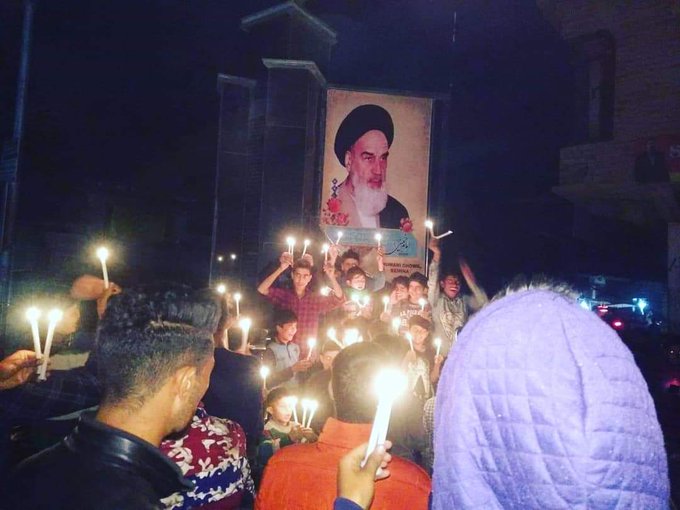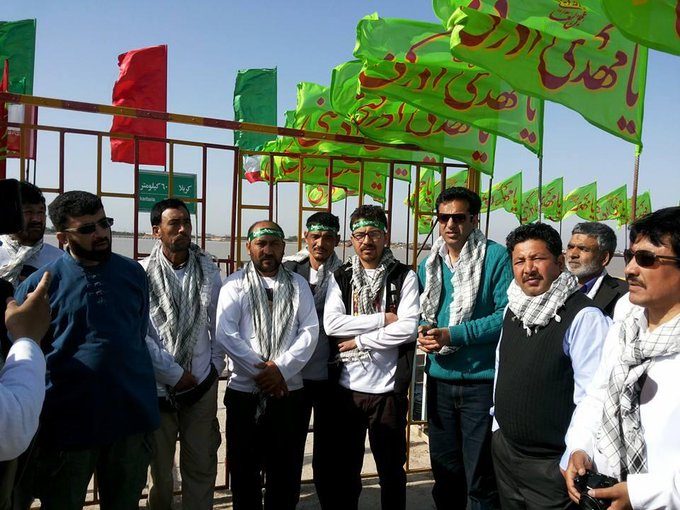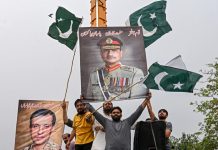The Kashmir conflict between India and Pakistan has so far remained a localized conflict. But thanks to Iran’s growing influence and entrenchment in Kashmir, particularly targeting its Shia population, that could be about to change. EurAsian Times brings you an OpEd by Abhinav Pandya written for the Israeli Media – Haaretz
The Disappearance of Shia Muslims In Pakistan – Is Saudi-Iran Rivalry Taking A Toll On Shia Muslims?
Other Muslim-majority states, from Saudi Arabia to Turkey, are jostling for position in Kashmir too, whether to counter Tehran or push their own political and religious agendas. But India’s politicians, strategic experts and its mammoth intelligence-bureaucracy aren’t ready for this internationalization of the Kashmiri conflict – and its dangerous consequences.
Iran is targeting the 1.4 million Shia Muslims who make up 15 per cent of the entire population of Indian-administered Kashmir. They are mostly concentrated in the Budgam district of Central Kashmir, parts of Srinagar and Kargil.
Despite a history of Shia-Sunni friction in Kashmir, the Sunnis mostly followed a syncretic and locally-rooted Sufi form of Islam, known as Kashmiriyat, that was particularly amenable to coexistence with diverse faiths and sects within Islam and other religions.
The sectarian divides have never been as virulent in Kashmir as in the Middle East – but now, Middle East states are exporting their partisan divisions to the territory.
Traditionally pro-India, Kashmir’s Shias are primarily seen by India’s security apparatus, think tank circles and popular opinion as a key bulwark against separatism which, for the overwhelming majority of its adherents, aims for an independent Kashmir. In the past, the Shia community has shunned separatism. But this, too, has begun to change.
Shias are not prominent proponents of the mainstream separatist narrative, but they are undergoing an ideological transformation towards a far greater sympathy for separatism, a cause that Iran enthusiastically supports. The younger generation of Shias are far more vulnerable to both Iranian indoctrination and to separatism.
It’s easy to observe the rapid rise in Iranian influence over Shias in Kashmir.
In a series of recent visits. I saw plenty of billboards celebrating Ayatollah Ruhollah Khomeini, the father of the Islamic revolution in Iran. In a place like Kargil, cut-off from the rest of the world by snow for six months a year, there are large Khomeini billboards and a burgeoning lay following that venerates him.
The identification with Iranian heroes goes further than just with the regime’s founding Supreme Leader. Mohsen Hojaji, the iconic Iranian Revolutionary Guards officer beheaded by ISIS, also drew a huge following among Kashmir’s Shias. Srinagar, the largest city, witnessed huge protests by Shia Muslims against the execution of Shia cleric Sheikh Nimr al-Nimr by Saudi Arabia. Streets in Shia areas are named after the Shia martyrs of the Iran-Iraq war.
Every year a significant number of Kashmiri Shia scholars visit seminaries in Iran and Iraq to study Shia Islam in its heartland. The traffic is not one way.
Iranian Shia scholars also visit Shia regions in Kashmir and have carved out a distinct niche for their preaching. Last year, the union government red-flagged the visit of Iranian scholars in Kashmir for giving fiery speeches in mosques and congregations. There is hardly any systematic research about the scale of these travelling preachers; whatever raw data is there, is a strict preserve of India’s intelligence agencies.
A progressive scholar from the Shia community described to me the increasing popularity of Iranian-Lebanese resistance literature among the Shia Muslims of Kashmir.
The Urdu translation of the biography of Dr. Mustafa Chamran, who participated in the Iranian revolution, and helped found Lebanon’s Shia militia, Amal, and biographies of Lebanese-Iranian Shia scholars Musa al-Sadr, who founded Amal, and Ayatollah Fadlallah, Hezbollah’s founding spiritual leader, are ubiquitous in Shia households and community libraries.
Shia Imam-baras, or congregational halls, religious processions, demonstrations, conventions and rallies feature posters of Hassan Nasrallah, the secretary-general of Hezbollah.
For Kashmiri Shias, who experience human rights abuses by Indian security forces such as inconvenient, humiliating security checks, sudden cordons, extensive search operations – including of their homes and land, extended curfews, beatings and even the killing of civilians like themselves, the message of resistance literature – that the answer to the suppression of the Shia community is resistance – has obvious resonances.
Residents in Khomeini Chowk, Bemina Srinagar (my home) hold a candle light vigil in solidarity with the victims of Kulgam massacre. May the oppressors perish.#KulgamMassacre #Kashmir
Iran has had a consistent policy on Kashmir since 1979. Ayatollah Ruhollah Khomeini had roots in Kashmir, and he once made it clear to a visiting Indian delegation that Indo-Iranian relations cannot prosper until the bloodletting in Kashmir is not stopped.
In May 1990, his successor Ayatollah Khamenei observed that the Kashmir conflict is about “truth and justice” and the (Indian) oppressors “have an unjust cause.” In 1994, Khamenei categorically stated that Kashmiris were facing tyranny and oppression at the hands of Indian forces, and their cause was one of justice and humanity.
As recently as last February, when discussing with foreign officials the problems faced by Muslims globally, Iran’s supreme leader included Kashmir with other conflict-ridden states like Afghanistan, Palestine, Bahrain, and Yemen, much to the chagrin of Indian authorities.
“Muslims the world over should openly support the people of Bahrain, Kashmir, and Yemen and repudiate the oppressors and tyrants who attacked people in Ramadan,” said Khamenei.
Though Iran has voted against India on the issue of Kashmir issue several times in sessions of the Organization of Islamic Cooperation, this was the first time Iran gave a distinctly religious colouring to the Kashmir insurgency, something which the local separatist leaders have so far refrained from doing.
When Burhan Wani, the poster boy of militancy in Kashmir, was killed in an encounter with security forces in 2016, it led to mass civil unrest in Kashmir. The Al Mustapha University in Mashad, Iran commemorated the anniversary of his death – the first time that a Kashmiri militant has been glorified in such a way in a foreign country other than Pakistan.
The Kashmiri progressive scholar told me that an overwhelming majority of the community has adopted Khamenei’s geopolitical outlook, which classifies the world into the oppressors, or “mustakbireen,” an axis of evil that traditionally included the U.S., UK, Israel and the West in general ; and the “mujtazafeen,” or oppressed, constituted by Palestine, Syria, Iraq, and Lebanon, also known as the “axis of resistance.”
Iran’s highest religious authorities have now classified the people of Kashmir, as well as Bahrain and Burma’s Rohingyas, as part of the axis of resistance. And it is not just offering Kashmiri Shia sympathy: Tehran is encouraging them to actualize the connection with Iran and the global Shia community by coming to fight for Shia militia and terrorist groups in the Middle East.
Young Shia boast of their connections to Iran-backed Shia terrorist groups like Hezbollah. In a place like Kashmir, where militancy is sometimes almost a fashion among younger people, boasting of access to transnational terrorist organizations is a gateway to social prestige and sometimes even monetary gain. That means some scepticism is warranted. But there are clearly sufficient grounds to research these claims of Hezbollah links, based on the clear evidence of Kashmiri Shia involvement in another Mideast battleground – Syria.
Iran made systematic attempts to recruit Kashmiris for Liwa Zainebiyoun, one of several pro-Assad Shia forces formed, trained and operated by Iran’s Revolutionary Guards. A number of veterans of fighting against ISIS in Fallujah and Mosul have returned to Kashmir.
Baseejs from #Kargil #Kashmir on visit to #Iran @khamenei_ir @Iran @IraqiFighters @VOT99 @ISOPAKKD
But at this stage, Shia radicalization is mostly ideological: Iran focuses its messaging on Shia global unity and strengthening the Kashmiri community’s connections and solidarity with the ideological, cultural, and intellectual Shia heartlands in the Middle East.
Along with this “Iranization,” separatist sentiment is developing fast within the Shia community.
The Shia community in Indian-administered Kashmir are caught between, and targeted by, several national and religious conflicts. They are a religious minority, and the far larger Sunni majority is overwhelmingly sympathetic to separatism – known as the Tahreek movement.
The Indian authorities have long assumed that Shias would be permanently committed to India’s sovereignty over the territory – squeezed as they are between Pakistan’s rising Sunni extremist violence, and the Sunni-controlled, Pakistan-backed separatist movement.
But this assumption has led taking Shia’s commitment to Indian control for granted. A veteran Shia leader from central Kashmir told me that Shias feel New Delhi values them more as “strategic assets” than as equal citizens.
Kashmiri Shias suffer from a deep deficit of trust and investment with New Delhi which has been simmering since 1947. Shias feel the Indian state has promoted a few token Shia elite families, such as the financially and politically powerful Ansaris, key figures in the religious hierarchy and whose members also serve as prominent lawmakers but allegedly have never encouraged the economic development of the community and the political participation of other Shias.
The young generation is angrily dissatisfied with community elites who allegedly received all the benefits accruing from their proximity to power, and did nothing for the socio-political development of the community. That resentment is fueled by allegations of colossal corruption by elite leaders, including grabbing for their own benefit the land belonging to the Aukaf, meant for the community’s religious needs cemeteries, mosques and community centers.
Alongside this alienation from India’s governing structures, Shias also face significant pressure from their Sunni neighbours. The community fears being seen as a traitor by Pakistan-backed terrorist groups, extremist organizations like Jamaat-i-Islami, and separatist political organizations like the All Parties Hurriyat Conference.
The Shia live in a perpetual state of threat from a separatist movement which is fast acquiring Sunni-extremist tones. To safeguard their lives, religious freedom and cultural identity, Kashmiri Shias now feel compelled to show their identification with separatism.
Shias have joined the separatist Hurriyat Conference – and one, Maulana Abbas Ansari, has even led it; his son has publicly confessed his admiration for the separatist “martyr” Burhan Wani, and displayed his portrait at the Shia Muharram mourning processions.
For younger Shia, there’s also the pull factor of the ‘glamor’ of separatist style and violence.

A new generation of homegrown militants, inspired by Burhan Wani, includes young professors, engineers, and Ph.D. scholars within its ranks. They’re a far cry from the image of separatists only a decade ago as illiterate and uncouth footsoldiers, graduates of primitive madrassahs.
These young separatists tote their guns and gadgets and post their action-snaps on social media – so much so that the older generation of militants call them “Facebook mujahids.” This new branding of separatists as young revolutionaries attracts a huge fan following across the religious and sectarian divide- among Shia youth, as well as their Sunni peers. Very few Shia have gone on to adopt violent separatism, but the conditions are maturing for that to happen.
For their part, the Sunni separatist hierarchy takes some care not to push the Shia community away through gratuitous abuse or insults in their prodigious Facebook and WhatsApp video messages. Even Zakir Musa, the commander of Ansar Ghazwat ul-Hind, Al-Qaida’s ideological front dedicated to an independent Kashmir ruled by Islamic law, has never pushed venomous messages against the Shia community.
There are other factors which may accelerate the eventual reach and depth of Iranian influence in Kashmir.
India’s tilt towards Israel is not popular at all with Kashmiris in general, as can be seen in a wealth of sceptical, if not hostile, social media posts. Many in the Shia community, traditionally pro-India, have expressed a strong hostility towards the emerging Indo-Israel bonhomie. India’s recent vote in favour of Israel in the UN was severely criticized in Kashmir.
Perhaps counter-intuitively, Iran appeals to Sunni Kashmiris too. Though Kashmir is a Sunni-majority state, Iran’s keen support for Muslims in conflict zones around the world is widely welcomed, far beyond the Shia community.
When Iran’s supreme leader urged Muslims to support the Kashmiri “freedom struggle,” Sunni Kashmiri separatist leaders warmly welcomed it. Syed Ali Shah Geelani, the most vocal and influential voice of the Kashmiri separatist Hurriyat Conference, called the statement “timely and pragmatic.”
Interestingly Iran’s support for the Kashmiri separatist struggle has come at a time when Sunni extremist organizations such as ISIS and Al-Qaida are making inroads in Kashmir. ISIS has already penetrated Kashmir, ideologically as well organizationally.
Recently, ISIS declared Kashmir a wilayat or one of its provinces. Al-Qaida chief Ayman Zawahiri urged Kashmiris in a recent video to unite to engage in jihad, and to attack government buildings and security installations.
Saudi Arabia’s robust involvement in Kashmir has also spurred Iran’s interest. Saudi non-government organizations have invested vast amounts in Kashmir to spread Salafism, and today, out of seven million people, about 1.6 million are Salafis. They have grown exponentially since 2011.
The spread of this non-indigenous, fundamentalist form of Islam has led to sectarian frictions (for instance, Sufi shrines have been set alight) and the rise of jihadi extremism that is foundationally hostile to Shias, non-Wahhabi Sunnis – such as the indigenous Etaqadi Sufis – and non-Muslims, a phenomenon that is entirely new to Kashmir.
But India’s response has been modulated by the changing geopolitical realities of the Middle East, and its overriding need to sustain good relations with Saudi Arabia.
In a recent crackdown on jihadi organizations radicalizing young Kashmiris, the government banned the Pakistan-backed Jamaat-i-Islami, but did not act against the Saudi-backed Ahl-i-Hadith. The Ahl-i-Hadith refrains from direct discussion of politics, including the Kashmir conflict, focusing on preaching an Arabized fundamentalist Islam. Policy experts believe that India can leverage its good ties with Saudis to put pressure on Ahl-i-Hadith groups in Kashmir to keep them in check.
Along with Tehran and Riyadh’s outreach efforts in Kashmir, Turkey, too, is staking a claim. Turkish authorities are making systematic attempts to woo clerics, youngsters, the business community, and intellectuals in Kashmir. The now-banned Jamaat–i-Islami has close connections with Turkey.
Erdogan’s ambitions to be the pre-eminent leader of the Muslim world face stiff resistance from the Saudis, and a U.S.-Iran face-off in the Middle East will make the Muslims of Kashmir an even more attractive population for him to cultivate. Turkey is likely to play a more active role in the socio-cultural, political, and intellectual life of Kashmir in the future.
Kashmir is becoming the ground zero for a new geopolitical race for influence: Iran and Turkey have deep, sometimes overlapping interests, Saudi Arabia wants to ensure a return on its financial and ideological investment, and all that before considering great power China’s determination to grow its influence.
The question is whether these states – who have carefully cultivated minority and majority populations in Kashmir, and prepared them for radicalization – will weaponize those supporters in a future proxy conflict between themselves, or between separatists and India itself.







